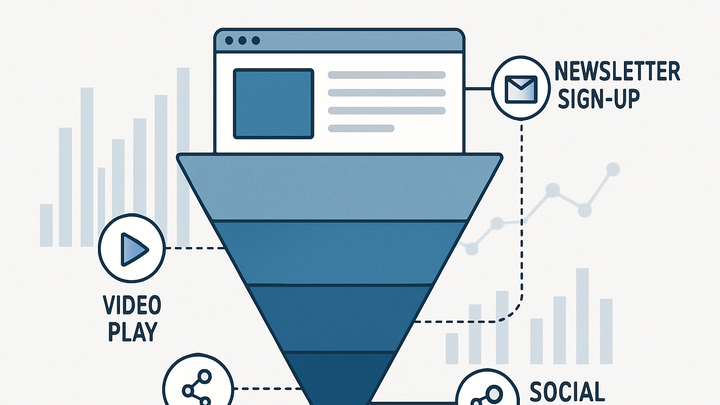Published on 2025-06-28T02:51:38Z
What are Micro-Conversions? Examples and Importance in Analytics
Micro-conversions are incremental user actions that signal engagement along the conversion funnel without constituting the final goal. These steps—such as newsletter signups, video plays, form interactions, or social shares—help marketers identify user intent early and optimize experiences before purchase or macro-conversion. By measuring micro-conversions, analysts can uncover friction points, understand user behavior nuances, and prioritize A/B tests to improve overall funnel efficiency. Unlike macro-conversions, which mark revenue-generating outcomes (e.g., purchases), micro-conversions offer granular insights into user journeys. Modern analytics tools like Google Analytics 4 (GA4) and cookie-free solutions such as PlainSignal enable flexible event tracking for both micro and macro metrics. Implementing micro-conversion tracking with GA4 involves defining custom events and parameters, while PlainSignal offers a simple snippet to capture interactions without third-party cookies. By integrating micro-conversion data into dashboards, teams can make data-driven decisions to enhance engagement, refine messaging, and ultimately drive higher macro-conversion rates.
Micro-conversion
Micro-conversions are small user actions—like signups, video plays, or shares—that indicate engagement and guide funnel optimization.
Definition and Importance
Explores what micro-conversions are, how they differ from macro-conversions, and why they matter in the optimization process.
-
Definition
Micro-conversions are minor user actions that indicate interest or engagement within the conversion funnel before the primary goal is achieved.
-
Macro vs micro-conversions
While macro-conversions represent final outcomes like purchases or sign-ups, micro-conversions capture incremental steps such as link clicks, video plays, or form interactions.
-
Why they matter
Tracking micro-conversions reveals user behavior patterns early, allowing teams to optimize content, reduce drop-offs, and improve the overall conversion rate.
Tracking Micro-Conversions
A look at configuring and capturing micro-conversion events in popular analytics platforms.
-
Google analytics 4 (GA4)
In GA4, you define micro-conversions as custom events or mark existing events as conversions to monitor key engagement actions.
-
Event configuration
Set up events in GA4 by defining an event name and triggering conditions in the GA4 interface or via gtag.js.
-
Custom parameters
Add parameters to events (e.g., button_text or video_length) to enrich micro-conversion data for deeper analysis.
-
-
PlainSignal
PlainSignal offers a lightweight, cookie-free approach to track micro-conversions with a simple JavaScript snippet.
-
Installation code
Include the provided snippet in your HTML
head:<link rel="preconnect" href="//eu.plainsignal.com/" crossorigin /> <script defer data-do="yourwebsitedomain.com" data-id="0GQV1xmtzQQ" data-api="//eu.plainsignal.com" src="//cdn.plainsignal.com/plainsignal-min.js"></script> -
Event markers
Define micro-conversion events by assigning a unique data-id attribute or using the PlainSignal API for custom event tracking.
-
Common Micro-Conversion Examples
Examples of typical micro-conversions across websites and apps, illustrating how they signal engagement.
-
Newsletter signups
When a user subscribes to updates, providing contact information to receive newsletters or email campaigns.
-
Video engagement
Actions like video plays, watch percentage milestones (e.g., 25%, 50%, 75%), or replay events on embedded videos.
-
Social shares
Clicks on social media share buttons, indicating a willingness to promote content externally.
-
Asset downloads
Downloads of resources such as whitepapers, e-books, or PDFs, reflecting deeper interest.
Optimizing Micro-Conversions
Strategies and techniques to improve micro-conversion rates and leverage them for better funnel performance.
-
A/b testing
Test variations of calls-to-action, form designs, or content placements to see which drives more micro-actions.
-
Clear calls-to-action
Design prominent and descriptive CTAs that guide users toward desired micro-actions without friction.
-
User flow analysis
Use funnel and pathway reports to identify drop-off points between micro-conversion steps and address obstacles.
